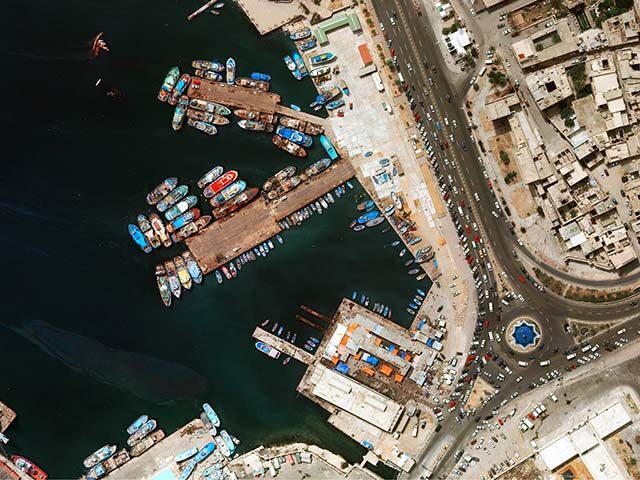The effort by shipping companies to reroute traffic from the Red Sea around the Cape of Good Hope, thus avoiding drone and missile attacks by the Iran-backed Houthi terrorists of Yemen, is running into major logistical hurdles because African ports are not ready to accommodate the surge of massive container ships and tankers.
Reuters noted the number of ships rerouting around the Cape of Good Hope quickly rose into the hundreds, which is not surprising since about 15 percent of the world’s trade flows through the Bab el-Mandeb Strait, Red Sea, and Suez Canal. Fully 30 percent of large container ships pass through the route threatened by the Houthis.
RELATED VIDEO — CNBC’s Croft: Attacks on Red Sea Vessels Show Gaza War “Spreading” Despite All the Assets We’ve Sent:
Rerouting around the Cape of Good Hope can add two weeks or more to shipping times between Europe and Asia, with a commensurate increase in cost, which the unsteady global economy is not well-positioned to absorb.
Logistics experts told Reuters that not many ports along the alternate African route are equipped to handle massive ships, and those that are have not been performing well:
South Africa’s major ports, including Durban, one of Africa’s largest in terms of container volumes handled, as well as Cape Town and Ngqura ports are among the worst performing globally, a World Bank 2022 index released in May found.
“Even the state that Durban is in now, it is still the most advanced and largest port in Africa, so ships rerouting around the continent have very limited choices for berthing for replenishment,” Alessio Lencioni, a logistics and supply chain consultant told Reuters.
Other large African deep-water ports along the Cape route, such as Mombasa in Kenya and Dar es Salaam in Tanzania are too ill-equipped to handle the expected traffic over the next couple of weeks, Lencioni said.
Topping off their tanks at points of origin in a bid to avoid intermediate layovers causes more logistical headaches for big container ships and tankers, and the weather around the Cape of Good Hope is nowhere near as favorable as the Red Sea, which makes ships burn more fuel.
The practice of sending fuel ships along shipping routes to refuel big freighters at sea, known as “bunkering,” sometimes runs into bureaucratic hurdles as ships pass through the territorial waters of nations with complex customs rules.
Bunkering also demands moving large stockpiles of fuel to ports that launch refueling ships, as few ports along the African coastal route have enough marine fuel on hand to handle thirsty cargo leviathans.
For all of these reasons, plus the much longer transit time, sending ships around the Cape of Good Hope is far more expensive than passage through the Red Sea and Suez Canal. Business Korea on Wednesday quoted analysts who said the extra costs of avoiding the Red Sea can add up to over $2 million per ship. Costs are especially high right now because under-supplied African ports are charging exorbitant prices for fuels that are suddenly in high demand.
Another problem is that ports along the Cape of Good Hope rarely stock biofuels or advanced mixtures that meet stringent European environmental regulations. Some shipping companies also tout high emissions standards for their ships, which are hard to meet with the fuel sold at previously low-traffic African ports.
The Houthis remain a menace to Red Sea shipping, with fresh missile and drone attacks reported on Saturday. U.S. and allied warships patrolling the Red Sea have demonstrated a high level of capability to intercept Houthi weapons. On Tuesday, a U.S. Navy destroyer assisted by carrier-launched fighters was able to intercept 12 Houthi drones and 5 missiles launched at Israel over a ten-hour period.
The shipping industry – and perhaps more importantly, the maritime insurance industry – are demonstrating mixed levels of confidence about the ability of the U.S.-led coalition to protect their vessels.
Danish shipping giant Maersk said on Sunday it is preparing to resume transit through the Red Sea “as soon as operationally possible.” Maersk suspended shipping through the Red Sea on December 15 after several of its vessels were attacked by the Houthis.
“The overall risk in the area is not eliminated at this stage,” Maersk added cautiously. “Maersk will not hesitate to re-evaluate the situation and once again initiate diversion plans if we deem it necessary for the safety of our seafarers.”
On the other hand, Germany’s Hapag-Lloyd said on Tuesday it still considers passage through the Red Sea “too dangerous,” and will continue rerouting its ships around the Cape of Good Hope. A Hapag-Lloyd spokesperson said the company will review its options again on Friday.

COMMENTS
Please let us know if you're having issues with commenting.